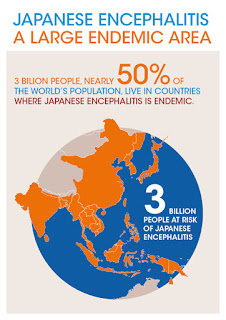The issue was first identified in Bhopal. There were three deaths in the city hospitals in the first week of June this year. The cause for all three deaths was Japanese Encephalitis virus. Within no time an alert was issued by the civic bodies. There were two key elements to this alert. Firstly, there was an urgent need to identify vulnerable areas and zones in the city and surrounding vicinities for which relevant agencies were put into action immediately. Secondly, the state government urged residents to stay cautious and alert. As a matter of fact, all these three patients that became the victim of this deadly virus were from adjoining districts. A further digging into the matter brought some more facts about the issue. Death records from January till May at Hamidia Hospital revealed almost 20 persons dying of viral Japanese Encephalitis with some astonishing facts.
 |
|
Out of these 20 deaths, five were minors and 12 were women. While these deaths occurred during the different time from January to May but most of these were in March. Eight persons died of Encephalitis viral in that month only. Experts in the field say that Japanese Encephalitis is a viral disease. The key agents spreading this virus are mosquitoes, wild birds, and pigs. As Harshit Tiwari, Deputy Commissioner, BMC (Bhopal Municipal Committee) says, “We have issued an alert in the city as three deaths were reported in the city. Though the deceased were not from the city, still we need to take preventive measures. We have launched an intensive check of the localities in the state capital and marked some areas as vulnerable. We have narrowed our focus to water coolers discarded after summer with water making it a breeding ground for vectors.”
 |
|
There is no proper cure for Japanese Encephalitis patient
Acknowledging that some sectors in Old and New Bhopal are most vulnerable in this respect, Tiwari adds, “We have scheduled a meeting on June 20 with the health department and malaria team, where we will get a list of the black spots of the city, where the probability of vector-borne disease risk is high.” It is important to understand why we call it by this name. Actually, the first case of this viral disease was found in Japan in 1871 and thus we call it by the name of Japanese Encephalitis. The recent three deaths in the first week of June include two kids and an adult. These two kids were from the districts of Vidisha and Hoshangabad. The adult was from Ashoknagar. While the two kids were being treated at Hamidia Hospital in the city, the third case was admitted to AIIMS, Bhopal. |
|
Both Hospitals confirmed that all the three patients’ blood samples were Japanese Encephalitis positive. As a matter of fact, there is no particular treatment once infection occurs in a patient. It is more of a matter of proper care. The symptoms of Japanese Encephalitis include high fever, stiffness in the neck, headache, coma, spastic paralysis, seizures, and disorientation. The fatality rate in 30% in these cases. That is why protection, awareness, and prevention is most important in these cases so that nobody falls prey to Japanese Encephalitis symptoms.


